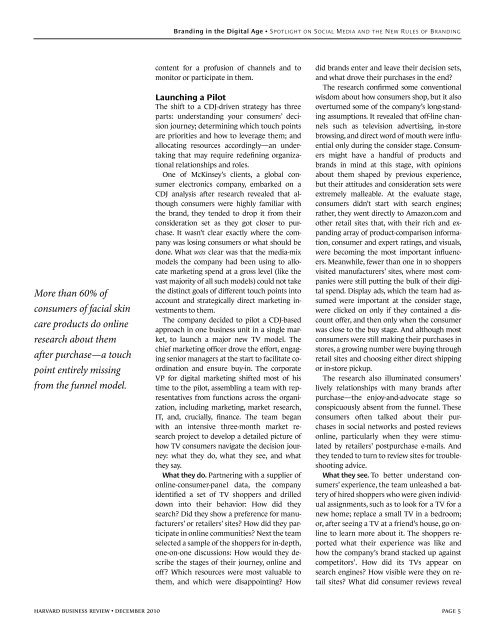Branding in the Digital Age - Edmar Bulla
Branding in the Digital Age - Edmar Bulla
Branding in the Digital Age - Edmar Bulla
Create successful ePaper yourself
Turn your PDF publications into a flip-book with our unique Google optimized e-Paper software.
More than 60% of<br />
consumers of facial sk<strong>in</strong><br />
care products do onl<strong>in</strong>e<br />
research about <strong>the</strong>m<br />
after purchase—a touch<br />
po<strong>in</strong>t entirely miss<strong>in</strong>g<br />
from <strong>the</strong> funnel model.<br />
<strong>Brand<strong>in</strong>g</strong> <strong>in</strong> <strong>the</strong> <strong>Digital</strong> <strong>Age</strong>•••SPOTLIGHT<br />
ON SOCIAL<br />
MEDIA<br />
AND THE NEW<br />
RULES<br />
OF BRANDING<br />
content for a profusion of channels and to<br />
monitor or participate <strong>in</strong> <strong>the</strong>m.<br />
Launch<strong>in</strong>g a Pilot<br />
The shift to a CDJ-driven strategy has three<br />
parts: understand<strong>in</strong>g your consumers’ decision<br />
journey; determ<strong>in</strong><strong>in</strong>g which touch po<strong>in</strong>ts<br />
are priorities and how to leverage <strong>the</strong>m; and<br />
allocat<strong>in</strong>g resources accord<strong>in</strong>gly—an undertak<strong>in</strong>g<br />
that may require redef<strong>in</strong><strong>in</strong>g organizational<br />
relationships and roles.<br />
One of McK<strong>in</strong>sey’s clients, a global consumer<br />
electronics company, embarked on a<br />
CDJ analysis after research revealed that although<br />
consumers were highly familiar with<br />
<strong>the</strong> brand, <strong>the</strong>y tended to drop it from <strong>the</strong>ir<br />
consideration set as <strong>the</strong>y got closer to purchase.<br />
It wasn’t clear exactly where <strong>the</strong> company<br />
was los<strong>in</strong>g consumers or what should be<br />
done. What was clear was that <strong>the</strong> media-mix<br />
models <strong>the</strong> company had been us<strong>in</strong>g to allocate<br />
market<strong>in</strong>g spend at a gross level (like <strong>the</strong><br />
vast majority of all such models) could not take<br />
<strong>the</strong> dist<strong>in</strong>ct goals of different touch po<strong>in</strong>ts <strong>in</strong>to<br />
account and strategically direct market<strong>in</strong>g <strong>in</strong>vestments<br />
to <strong>the</strong>m.<br />
The company decided to pilot a CDJ-based<br />
approach <strong>in</strong> one bus<strong>in</strong>ess unit <strong>in</strong> a s<strong>in</strong>gle market,<br />
to launch a major new TV model. The<br />
chief market<strong>in</strong>g officer drove <strong>the</strong> effort, engag<strong>in</strong>g<br />
senior managers at <strong>the</strong> start to facilitate coord<strong>in</strong>ation<br />
and ensure buy-<strong>in</strong>. The corporate<br />
VP for digital market<strong>in</strong>g shifted most of his<br />
time to <strong>the</strong> pilot, assembl<strong>in</strong>g a team with representatives<br />
from functions across <strong>the</strong> organization,<br />
<strong>in</strong>clud<strong>in</strong>g market<strong>in</strong>g, market research,<br />
IT, and, crucially, f<strong>in</strong>ance. The team began<br />
with an <strong>in</strong>tensive three-month market research<br />
project to develop a detailed picture of<br />
how TV consumers navigate <strong>the</strong> decision journey:<br />
what <strong>the</strong>y do, what <strong>the</strong>y see, and what<br />
<strong>the</strong>y say.<br />
What <strong>the</strong>y do. Partner<strong>in</strong>g with a supplier of<br />
onl<strong>in</strong>e-consumer-panel data, <strong>the</strong> company<br />
identified a set of TV shoppers and drilled<br />
down <strong>in</strong>to <strong>the</strong>ir behavior: How did <strong>the</strong>y<br />
search? Did <strong>the</strong>y show a preference for manufacturers’<br />
or retailers’ sites? How did <strong>the</strong>y participate<br />
<strong>in</strong> onl<strong>in</strong>e communities? Next <strong>the</strong> team<br />
selected a sample of <strong>the</strong> shoppers for <strong>in</strong>-depth,<br />
one-on-one discussions: How would <strong>the</strong>y describe<br />
<strong>the</strong> stages of <strong>the</strong>ir journey, onl<strong>in</strong>e and<br />
off? Which resources were most valuable to<br />
<strong>the</strong>m, and which were disappo<strong>in</strong>t<strong>in</strong>g? How<br />
did brands enter and leave <strong>the</strong>ir decision sets,<br />
and what drove <strong>the</strong>ir purchases <strong>in</strong> <strong>the</strong> end?<br />
The research confirmed some conventional<br />
wisdom about how consumers shop, but it also<br />
overturned some of <strong>the</strong> company’s long-stand<strong>in</strong>g<br />
assumptions. It revealed that off-l<strong>in</strong>e channels<br />
such as television advertis<strong>in</strong>g, <strong>in</strong>-store<br />
brows<strong>in</strong>g, and direct word of mouth were <strong>in</strong>fluential<br />
only dur<strong>in</strong>g <strong>the</strong> consider stage. Consumers<br />
might have a handful of products and<br />
brands <strong>in</strong> m<strong>in</strong>d at this stage, with op<strong>in</strong>ions<br />
about <strong>the</strong>m shaped by previous experience,<br />
but <strong>the</strong>ir attitudes and consideration sets were<br />
extremely malleable. At <strong>the</strong> evaluate stage,<br />
consumers didn’t start with search eng<strong>in</strong>es;<br />
ra<strong>the</strong>r, <strong>the</strong>y went directly to Amazon.com and<br />
o<strong>the</strong>r retail sites that, with <strong>the</strong>ir rich and expand<strong>in</strong>g<br />
array of product-comparison <strong>in</strong>formation,<br />
consumer and expert rat<strong>in</strong>gs, and visuals,<br />
were becom<strong>in</strong>g <strong>the</strong> most important <strong>in</strong>fluencers.<br />
Meanwhile, fewer than one <strong>in</strong> 10 shoppers<br />
visited manufacturers’ sites, where most companies<br />
were still putt<strong>in</strong>g <strong>the</strong> bulk of <strong>the</strong>ir digital<br />
spend. Display ads, which <strong>the</strong> team had assumed<br />
were important at <strong>the</strong> consider stage,<br />
were clicked on only if <strong>the</strong>y conta<strong>in</strong>ed a discount<br />
offer, and <strong>the</strong>n only when <strong>the</strong> consumer<br />
was close to <strong>the</strong> buy stage. And although most<br />
consumers were still mak<strong>in</strong>g <strong>the</strong>ir purchases <strong>in</strong><br />
stores, a grow<strong>in</strong>g number were buy<strong>in</strong>g through<br />
retail sites and choos<strong>in</strong>g ei<strong>the</strong>r direct shipp<strong>in</strong>g<br />
or <strong>in</strong>-store pickup.<br />
The research also illum<strong>in</strong>ated consumers’<br />
lively relationships with many brands after<br />
purchase—<strong>the</strong> enjoy-and-advocate stage so<br />
conspicuously absent from <strong>the</strong> funnel. These<br />
consumers often talked about <strong>the</strong>ir purchases<br />
<strong>in</strong> social networks and posted reviews<br />
onl<strong>in</strong>e, particularly when <strong>the</strong>y were stimulated<br />
by retailers’ postpurchase e-mails. And<br />
<strong>the</strong>y tended to turn to review sites for troubleshoot<strong>in</strong>g<br />
advice.<br />
What <strong>the</strong>y see. To better understand consumers’<br />
experience, <strong>the</strong> team unleashed a battery<br />
of hired shoppers who were given <strong>in</strong>dividual<br />
assignments, such as to look for a TV for a<br />
new home; replace a small TV <strong>in</strong> a bedroom;<br />
or, after see<strong>in</strong>g a TV at a friend’s house, go onl<strong>in</strong>e<br />
to learn more about it. The shoppers reported<br />
what <strong>the</strong>ir experience was like and<br />
how <strong>the</strong> company’s brand stacked up aga<strong>in</strong>st<br />
competitors’. How did its TVs appear on<br />
search eng<strong>in</strong>es? How visible were <strong>the</strong>y on retail<br />
sites? What did consumer reviews reveal<br />
harvard bus<strong>in</strong>ess review • december 2010 page 5


